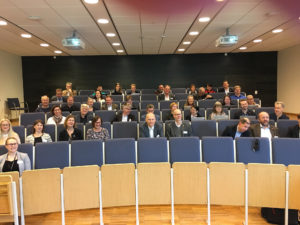(Original Swedish post published 15 March.)
Today the inquiry chair appointed by the government, Jörgen Tholin, presented his report, “Admissions for new students – a more transparent and comprehensible system for admissions to higher education”. See the press conference here (in Swedish) and read the inquiry report here (in Swedish). The review is much needed. The current regulations on higher education entry requirements, admission and selection procedures are unclear, complicated and difficult to understand. At a first glance, the proposals look good. The situation will become simpler and more consistent. Choices made in upper secondary school will have a less decisive role, and an entrance examination will be introduced for applicants who do not meet general entry requirements. It’s a good thing that the Swedish Scholastic Aptitude Test will become less important and that a lower age limit will be introduced for the test. The abolition of credit increments and field-specific entry requirements is positive. Some work remains to be done and further clarifications are needed before the proposals are put into effect.
Today over 1,200 upper secondary school pupils visited us to learn about studying at Uppsala University. We rolled out the red carpet for them and flew the flags. They got to meet students and study advisers, heard student orchestras and got masses of information about studies, student life, the student nations and much more. We look forward to seeing them again when it’s time for university.
Once a term we have a deans meeting, often as a lunch-to-lunch meeting at a residential conference centre, but this time in the form of a full day at Blåsenhus. Apart from an introductory survey of ongoing developments at the University and in the higher education sector, the agenda featured two future-oriented items.
The morning was devoted to the the University’s comprehensive plan, Development Plan 2050, on which work has now begun. Previous premises provision plans – put simply – have come about as aresult of the Buildings Division asking the departments about their needs in the years ahead and planning new premises based on their responses. Now we’re raising our sights and adding a more long-term strategic planning perspective by setting the development of the University’s premises, buildings and resources in relation to our ambitions as expressed in our Mission and Core Values. What must we do to maintain our control over expansion areas so that we can develop, raise new buildings and plan not just in the short and medium term, but also in the truly long term? What will the University need 100 years from now?
We had a lively discussion about housing for students and employees, flexible premises for research and education, study areas, and cooperation with the municipality, the city and other actors outside the University. The discussion also extended to the question of what kind of university we are. Our identity embraces the modern and the medieval alike. How should we use our flagship buildings – the University Main Building, Carolina Rediviva and Gustavianum? Should we build new ‘landmarks’? What can we do to enhance our attractiveness so as to maintain our relevance for students and employees – nationally and internationally? The same questions also apply to development of the Campus Gotland environment. This was the first of a series of discussions that we will have in the course of producing the development plan.
The afternoon was devoted to a quite different question – the ongoing revision of the University’s rules of procedure. These rules formalise the University’s governance and management. The deans meeting was visited by the University-wide working group that is taking stock of the issues that need to be regulated in the document. After an introduction from the chair of the working group, Professor Lena Marcusson, the deans meeting was put to work. Group discussions tackled questions such as: What do we mean by collegiality? Which issues should be regulated in the rules of procedure? Who decides, about what, when and how? How are we to get people involved so as to ensure democracy and broad support? How are the vice-chancellor, deputy vice-chancellor, deans, heads of department to be appointed? The deans meeting passed on its views to the working group. Now the stocktaking process and discussions on the rules of procedure will continue. Other types of meetings are planned so there will be many opportunities for people to state their opinions. The working group will submit its proposals in September. The proposals will then be circulated for comment before the University Board makes a decision at the end of the year.
The day ended with reports from the vice-rectors, student representatives and University Director on what’s happening in their various areas of activity. It’s impressive to hear about so many exciting developments – many new buildings, new research initiatives ranging from the Antiobiotics Centre to multidisciplinary studies on racism, and new recruitments of doctoral students and assistant senior lecturers. It was a good deans meeting, characterised by a great spirit of engagement in education and research – and in Uppsala University.

